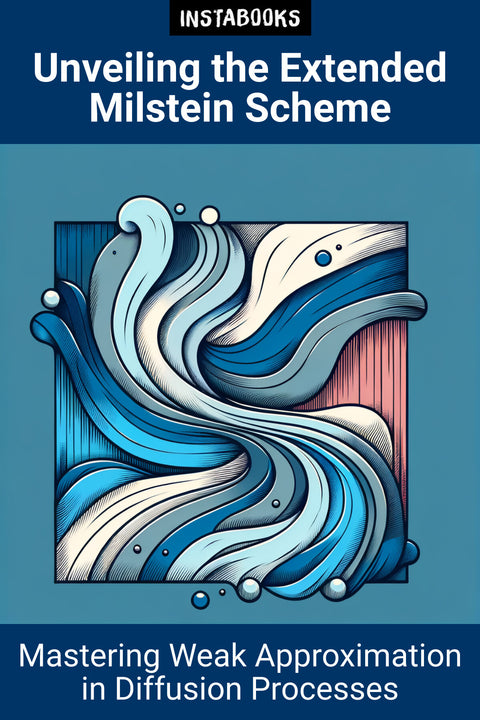
Instabooks AI (AI Author)
Unveiling the Extended Milstein Scheme
Mastering Weak Approximation in Diffusion Processes
Premium AI Book (PDF/ePub) - 200+ pages
Introduction to the Extended Milstein Scheme
The extended Milstein scheme represents a significant advancement in the field of stochastic differential equations (SDEs), offering a refined approach to approximating solutions with a focus on effective weak approximation of diffusion processes. This book unravels the complexities of this technique, highlighting its convergence properties, practical implementations, and its synergetic integration with multilevel Monte Carlo methods. By exploring these dimensions, readers will gain a deep understanding of the scheme's potential in advancing numerical analysis and applied mathematics.
Convergence Properties: A Closer Look
One of the foremost attributes of the extended Milstein scheme is its weak convergence rate of one, aligning with classical methods like the Euler-Maruyama and Milstein schemes while surpassing them by mitigating more leading-order error terms. This makes the scheme particularly advantageous when dealing with diffusion coefficients involving small parameters, ensuring higher accuracy in optimal simulation conditions. Readers will find a thorough examination of error reduction strategies that underline the method's sophistication.
Practical Implementations and Innovations
In practical terms, the extended Milstein scheme shines with its remarkable adaptability and efficiency. It employs Gaussian variates akin to the Euler-Maruyama method but with superior computational efficacy. Its explicit formulation, suitable for a broad spectrum of diffusions, and its enhancement of the truncated Milstein scheme with additional stochastic Taylor expansion terms of drift coefficients, are discussed extensively. The book provides step-by-step guidance on implementing these techniques across various scenarios, simplifying complex concepts for better comprehension.
Integration with Multilevel Monte Carlo Methods
The book delves into the integration of the extended Milstein scheme with multilevel Monte Carlo (MLMC) approaches. This combination is pivotal for achieving higher order variance convergence rates, promising significant reductions in computational complexity and enabling an O(ϵ^(-2)) complexity bound. By detailing the reduction in variance of the combined estimator, this text equips readers with the tools to leverage these advanced methods for achieving a Mean Square Error (MSE) of O(ϵ^2) efficiently.
Applications and Future Directions
Practical applications, such as Asian option pricing, wherein the extended Milstein scheme has demonstrated its superiority over traditional methods, are thoroughly explored. The text further touches on future research directives, including a priori convergence analysis and extending the scheme to multi-dimensional SDEs. The potential incorporation of quasi-Monte Carlo methods is also considered, highlighting avenues for further advancements in computational finance and related fields.
Table of Contents
1. Understanding the Basics- Introduction to SDEs
- Classical Numerical Approaches
- The Need for Extended Schemes
2. The Extended Milstein Scheme
- Formulation and Design
- Key Differences from Classical Schemes
- Advantages in Weak Approximation
3. Convergence Analysis
- Weak Convergence Rates
- Error Term Reduction
- Comparative Analysis
4. Implementing the Scheme
- Simulation Techniques
- Algorithm Efficiency
- Practical Applications
5. Multilevel Monte Carlo Methods
- Basic Concepts and Principles
- Integration with Milstein Scheme
- Computational Benefits
6. Applications in Financial Mathematics
- Asian Option Pricing
- Volatility Modeling
- Market Simulations
7. Advancements in Variance Reduction
- MLMC Variance Reduction
- Optimization Strategies
- Quantifying Efficiency Gains
8. Challenges and Solutions
- Handling Complexity in Simulations
- Balancing Accuracy and Speed
- Common Pitfalls and Fixes
9. Beyond One-dimensional SDEs
- Extension to Multidimensional Problems
- Addressing Computational Demands
- Case Studies and Examples
10. Integrating Quasi-Monte Carlo Methods
- Theoretical Foundations
- Practical Integration Challenges
- Future Research Opportunities
11. Comparative Studies
- Benchmarking Against Standard Schemes
- Parameter Sensitivity Analysis
- Empirical Findings
12. Future Directions and Research
- A Priori Convergence Analysis
- Innovations in Computational Techniques
- Prospective Developments and Trends
Target Audience
This book is written for quantitative analysts, financial engineers, and researchers interested in stochastic differential equations, numerical methods, and computational finance.
Key Takeaways
- Comprehensive understanding of the extended Milstein scheme for diffusion processes.
- Detailed insights into weak convergence properties and error reduction.
- Practical guidance on implementing and simulating the scheme.
- Exploration of integration with multilevel Monte Carlo methods.
- Applications in financial mathematics, including option pricing.
How This Book Was Generated
This book is the result of our advanced AI text generator, meticulously crafted to deliver not just information but meaningful insights. By leveraging our AI book generator, cutting-edge models, and real-time research, we ensure each page reflects the most current and reliable knowledge. Our AI processes vast data with unmatched precision, producing over 200 pages of coherent, authoritative content. This isn’t just a collection of facts—it’s a thoughtfully crafted narrative, shaped by our technology, that engages the mind and resonates with the reader, offering a deep, trustworthy exploration of the subject.
Satisfaction Guaranteed: Try It Risk-Free
We invite you to try it out for yourself, backed by our no-questions-asked money-back guarantee. If you're not completely satisfied, we'll refund your purchase—no strings attached.
